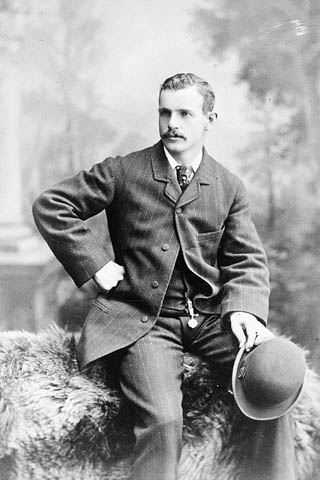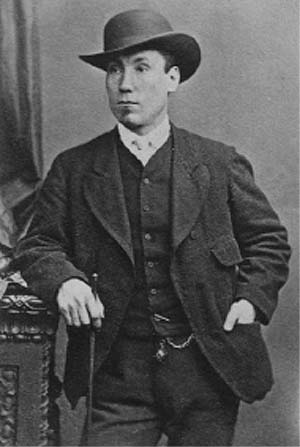
Edward Hanlan was a Canadian professional sculler, hotelier, and alderman from Toronto, Ontario.

Edward "Ned" Trickett was an Australian rower. He was the first Australian to be recognised as a world champion in any sport, after winning the World Sculling Championship in 1876, a title he held until 1880, when he was beaten by Canadian Ned Hanlan.

Harry Clasper was a professional rower and boat builder from Tyneside in England. He was an innovative boat designer who pioneered the development of the racing shell and the use of outriggers. He is said to have invented spoon-shaped oars.
Harry Kelley (1832–1914) was a famous professional oarsman on the Thames. He became the Tyne, Thames, English and World Sculling Champion, a title he won four times.

Robert Chambers was a famous Tyneside professional oarsman. He became the Tyne, Thames, English and World Sculling Champion.

James Renforth was an English Tyneside professional oarsman. He became the World Sculling Champion in 1868 and was one of three great Tyneside oarsmen, the other two being Harry Clasper and Robert Chambers.
Robert Coombes, celebrated professional oarsman and Champion Sculler, was born at Vauxhall, Surrey.

Charles Edward Courtney was an American rower and rowing coach from Union Springs, New York. A carpenter by trade, Courtney was a nationally known amateur rower. Courtney never lost a race as an amateur and finished a total of 88 victories.
Joseph Henry Sadler was a British professional rower who twice won the World Sculling Championship. Before 1876, the English Sculling Championship was considered to be the premier event in professional sculling. In 1876, the English Title gained the World status and earlier winners were retrospectively given the title of World Champion.
Peter Kemp (1853-1921) was one of seven Australians who each won the World Sculling Championship (Professional) between 1876 and 1905.
William Fawcus and member of Tynemouth Rowing Club was a British rower who won the Wingfield Sculls and the Diamond Challenge Sculls at Henley Royal Regatta in 1871, being the first provincial competitor to do so.
Wallace Ross was a professional rower who was considered to be the greatest sculler to come out of Saint John, Canada. He was a champion who nearly won the World Champion single sculls title.

James Arthur Messenger was the professional single sculls world champion from 1854 to 1857. He served as the Queen's Bargemaster from 1862 to 1901. He resided in Teddington. In 1854 he became the Champion of the Thames which was effectively the English Sculling Championship and the World Sculling Championship. The English title gained the world status in 1876, earlier winners were retrospectively given the world champion title. In 1862 he won the famed Doggett's Coat and Badge, which claims to be the oldest sporting championship in the world. There is some confusion as to whether James Messenger who won the World Sculling Championship in 1854 is the same person, recorded as John Messenger of Cherry Garden Stairs, who won the Doggett's Coat and Badge in 1862.

Elias Connell Laycock was an Australian competitive rower who three times tried to become the World Sculling Champion.

Charles Amos Messenger, a professional sculler and rower, was born in London where his family was well known in aquatic circles. He married Annie Frances Atkinson on 30 November 1875 in Gore Street, Fitzroy, Victoria, and died in Sydney, Australia.
Charles Stephenson was a New Zealand rower. He was born in Hobson Street, Auckland. He passed most of his boyhood at the Thames, and after leaving school went to the Northern Wairoa district, where he took to a bushman's life. His work in the kauri bushes was varied by an occasional spell as a boatman on the river, and so he got his first lessons in rowing. For three years he was in the service of the Hon. E. Mitchelson, at Dargaville, and during that time got a good deal of rough practice in rowing. His first race was rowed, with J. Wilson as a partner, in the pairs at the Wairoa Regatta in April 1887. Their principal opponents were the Brothers Brown, who were recognised at the time as the "bosses" of the river. To the surprise of everyone young Stephenson and his mate won easily. The Browns were not satisfied with their defeat, and a match was made with their conquerors for £50 a-side, to come off a month after the regatta. This had the same result, and Stephenson's reputation began to grow. In January 1888, he was one of the Northern Wairoa Whaleboat Crew which finished third at Auckland Anniversary Regatta. Waitemata winning and North Shore rowing second. After this he went back to the bush; but in November 1888, he and two friends left the Wairoa, intending to go to Tasmania. Stephenson, however, got no further than Sydney, where he determined to try his luck as a professional sculler.
William Hearn was a champion professional sculler of New Zealand, who emigrated to Victoria at a young age. He came to New Zealand in 1862, and had been a resident in Wellington since January 1876, nearly all the time having been employed by Messrs Greenfield and Stewart, timber merchants.
William Elliott was born at Hay Farm, Northumberland, 28 November 1849 and was the Professional Sculling Champion of England. He stood five feet seven and one half inches in height and untrained he weighed 176 pounds; trained, 167 pounds.
The English Sculling Championship developed out of informal competitions between working watermen on rivers such as the Thames and the Tyne. Various matches were made on a casual basis but in time these were more formalised. The first recognised Champion was Charles Campbell (rower) who beat John Williams in September 1831 on the Thames. Various persons then held the Championship which was gained under the challenge system. In June 1876 Edward Trickett of Australia won the Championship and then the Title became the World Sculling Championship See this entry for a list of Champions and races, and other details, from 1831 to 1876.

William Joseph O'Connor was a professional oarsman who attempted to win the World Sculling Championship. He was also a tavern-keeper and long distance walker. He was born in Toronto, and grew up in the cities' Irish district of Corktown. His parents were Michael and Ellen O'Connor and he died unmarried in Toronto.









